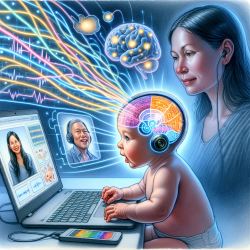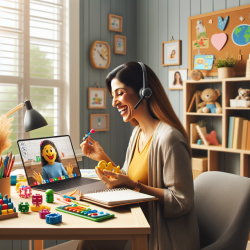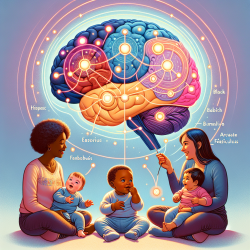Introduction
As a speech-language pathologist, understanding the intricate development of speech processing in infants is crucial for tailoring effective interventions. The recent study titled "The Development of Cortical Responses to the Integration of Audiovisual Speech in Infancy" provides valuable insights into how infants process speech through multisensory integration. This blog will explore how these findings can be applied to enhance online therapy services, such as those offered by TinyEYE, to improve outcomes for young children.
Understanding Audiovisual Speech Integration
The study utilized functional near-infrared spectroscopy (fNIRS) to examine how infants at 5 and 10 months respond to audiovisual speech. It was found that both age groups exhibited cortical responses indicative of both super-additive and sub-additive integration in the fronto-temporal cortex. Interestingly, while 5-month-olds showed widespread responses, these became more focal by 10 months, suggesting a reorganization in cortical processing as infants age.
Implications for Online Therapy
For practitioners providing online therapy, these findings underscore the importance of incorporating multisensory stimuli into therapeutic activities. Here are some practical strategies:
- Multisensory Engagement: Use videos that combine clear visual articulation with synchronized audio to stimulate both auditory and visual pathways, enhancing speech perception.
- Age-Appropriate Content: Tailor audiovisual materials to the developmental stage of the child, recognizing that younger infants may benefit from more varied stimuli while older infants might respond better to focused, repeated exposure.
- Interactive Sessions: Encourage active participation through interactive games that require infants to respond to audiovisual cues, reinforcing their integration skills.
Encouraging Further Research
The study highlights the need for continued research into how infants integrate sensory information and how this impacts language development. Practitioners can contribute by documenting their observations and outcomes from using audiovisual materials in therapy, potentially collaborating with researchers to refine techniques and materials.
Conclusion
Integrating the latest research findings into practice can significantly enhance the effectiveness of online therapy services for infants. By focusing on multisensory engagement and adapting to developmental stages, practitioners can foster better speech and language outcomes. To delve deeper into the original research, please follow this link: The Development of Cortical Responses to the Integration of Audiovisual Speech in Infancy.










